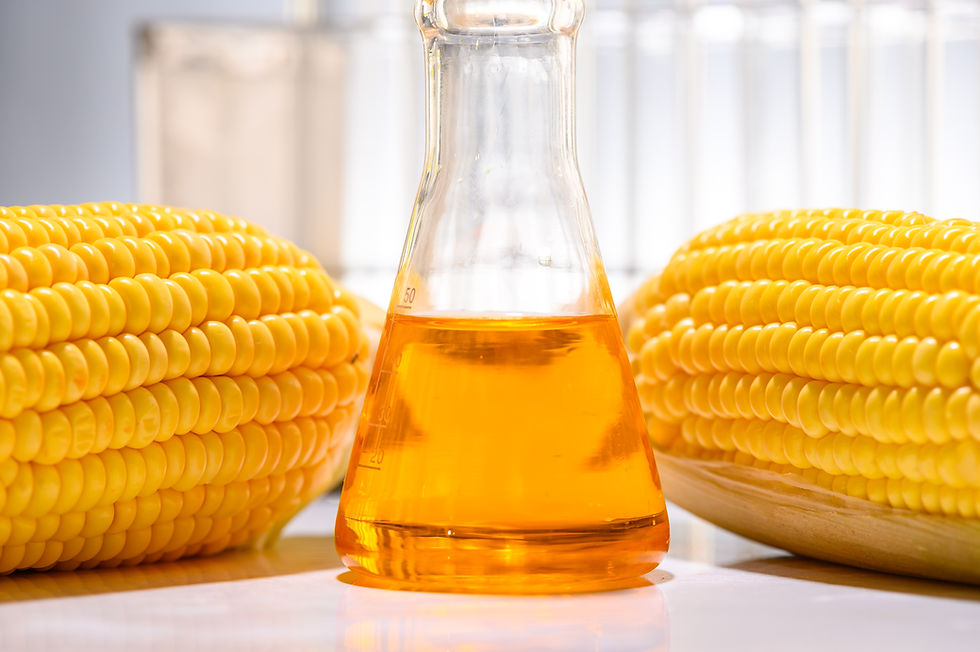High-Fructose Corn Syrup - the Bad and the Ugly
- Denise Scott
- Jul 17, 2024
- 2 min read
High-fructose corn syrup (HFCS) is a corn starch product that is an artificial sugar. Corn syrup, made from corn starch, is all glucose. Enzymes are added to corn syrup to make HFCS. These enzymes convert some of the glucose to fructose. The corn syrup now is high in fructose, thus the name.

Photo of corn syrup and corn on the cob which is used to make high-fructose corn syrup.
In the US, HFCS is either 42% or 55% fructose, designated as HFCS 42 (mainly used in processed foods, cereals, and baked goods) or HFCS 55 (primarily used in sodas). It was first marketed in the 1970s and is much cheaper than regular sugar.
HFCS is considered a culprit in today’s obesity epidemic.
Fructose also occurs naturally in fruit, some vegetables, and honey. The fructose contained in natural foods (fruit and vegetables) is not problematic since these foods provide nutrients and fiber. All the additional fructose we consume in processed foods is unhealthy.
Why is more fructose a problem?
We process glucose and fructose differently. Glucose is our primary fuel source for energy and is absorbed and metabolized readily.
Fructose is processed through the liver and converted to glucose, glycogen, or fat. An increase in fructose leads to an increase in triglyceride production. High intake of this sugar can lead to fatty liver disease. Studies show that diets high in HFCS can increase appetite, affecting appetite control centers in the brain.
What are some sources of HFCS?
Sodas
Fruit juice drinks
Candy
Packaged sweets and pastries
Fast food
Ice cream and ice pops
Jams, jellies, and preserves
Syrups - pancake and dessert syrups, but not pure maple syrup
Refined carbohydrates such as breads and crackers
Breakfast foods
Sweetened applesauce
Many condiments, dips, and sauces
Granola and protein bars
Some nut butters


Pictured above are a variety of processed food items with HFCS including candies, cookies, ice cream, juice, breads, jams, jellies, syrups, and condiments.
Interestingly, Coca-Cola and Pepsi continue to use cane sugar or sucrose in other nations but have used HFCS in the US since the 1980s.

Coke vs Pepsi - both are loaded with HFCS in this country but cane sugar in others. Each is equally unhealthy.
Considering that sugar-sweetened beverages account for more than half the sugar consumption in this country, why aren’t these companies accountable for the adverse health effects their products cause?
This year, House Bill 1074 was introduced in Indiana to ban HFCS as a food ingredient. Should it pass, other states may follow suit.
Adverse effects of high fructose intake include:
Weight gain and risk of obesity
Metabolic syndrome
Type 2 diabetes
Fatty liver disease (non-alcoholic fatty liver disease, NAFLD)*
Heart disease
Inflammation
Tooth decay
Alterations in the gut microbiota
*Of note, patients with NAFLD were found to consume twice as many calories from HFCS beverages than healthy patients.
The American Heart Association and American Academy of Pediatrics recommend that women and children not exceed six teaspoons or 25 grams of added sugar daily, equal to about 100 calories.
Avoiding this non-nutritive, artificial sugar additive by reading labels and avoiding many processed foods and beverages is a step you can easily take to improve your and your child’s health and risk of future disease.




Comments